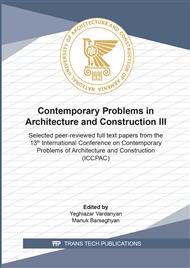[1]
M.K. Mohan, A.V. Rahul, G. De Schutter, K. Van Tittelboom, Early age hydration, rheology and pumping characteristics of CSA cement-based 3D printable concrete, Construction and Building Materials. 275 (2021) 122136.
DOI: 10.1016/j.conbuildmat.2020.122136
Google Scholar
[2]
V. Nguyen-Van, B. Panda, G. Zhang, H. Nguyen-Xuan, P. Tran, Digital design computing and modelling for 3D-concrete printing, Automation in Construction. 123 (2021) 103529.
DOI: 10.1016/j.autcon.2020.103529
Google Scholar
[3]
V.S. Lesovik, E.S. Glagolev, M.Y. Elistratkin, M.A. Pospelova, N.I. Alfimova, The method of creating and measuring the printability of fine-grained concrete, Materials Science Forum. 1017 (2021) 71-80.
DOI: 10.4028/www.scientific.net/msf.1017.71
Google Scholar
[4]
G.S. Slavcheva, O.V. Artamonova, M.A. Shvedova, E.A. Britvina, Effect of Viscosity Modifiers on Structure Formation in Cement Systems for Construction 3D Printing, Inorganic Materials. 57 (2021) 94-100.
DOI: 10.1134/s0020168521010143
Google Scholar
[5]
T.Q. Duong, E. Korolev, A. Inozemtcev, Selection of Reinforcing Fiber for High-strength Lightweight Concrete for 3D-Printing, IOP Conference Series: Materials Science and Engineering. 1030 (2021) 012007.
DOI: 10.1088/1757-899x/1030/1/012007
Google Scholar
[6]
M. Siwei, H. Cihang, B. Prince, N. Tommy, L. Na, The influence of water-to-cement ratio and superabsorbent polymers (SAPs) on solid-like behaviors of fresh cement pastes, Construction and Building Materials. 275 (2021) 122160.
DOI: 10.1016/j.conbuildmat.2020.122160
Google Scholar
[7]
A.S. Inozemtcev, E.V. Korolev, T.Q. Duong, Physical and mechanical properties of cement stone with superabsorbent polyacrylate solutions, Magazine of Civil Engineering. 89 (2019) 179-186.
Google Scholar
[8]
A.J. Klemm, F.S.R. Almeida, K.S. Sykora, The use of superabsorbent polymers (SAP) in binders based on multicomponent cements, CPI - Concrete Plant International. 4 (2016) 44-52.
Google Scholar
[9]
J. Yang, L. Liu, Q. Liao, J. Wu, L. Zhang, Effect of superabsorbent polymers on the drying and autogenous shrinkage properties of self-leveling mortar, Construction and Building Materials. 201 (2019) 401-407.
DOI: 10.1016/j.conbuildmat.2018.12.197
Google Scholar
[10]
D.Yu. Popov, V.S. Lesovik, V.S. Mescherin, Influence of superabsorbent polymers on plastic shrinkage of cement stone, Bulletin of the Belgorod State Technological University named after V.G. Shukhova. 11 (2016) 6-12.
DOI: 10.12737/22455
Google Scholar
[11]
Ch. Schröfl, V. Mechtcherine, M. Gorges, Relation between the molecular structure and the efficiency of superabsorbent polymers (SAP) as concrete admixture to mitigate autogenous shrinkage, Cement and Concrete Research. 42 (2012) 865-873.
DOI: 10.1016/j.cemconres.2012.03.011
Google Scholar
[12]
L. Senff, R.C.E. Modolo, G. Ascensao, D. Hotza, J.A. Labrincha, Development of mortars containing superabsorbent polymer, Construction and Building Materials. 95 (2015) 575-584.
DOI: 10.1016/j.conbuildmat.2015.07.173
Google Scholar
[13]
J. Yang, F. Wang, X. He, Y. Su, Pore structure of affected zone around saturated and large superabsorbent polymers in cement paste, Cement and Concrete Composites. 97 (2019) 54-67.
DOI: 10.1016/j.cemconcomp.2018.12.020
Google Scholar
[14]
F. Wang, J. Yang, S. Hu, X. Li, H. Cheng, Influence of superabsorbent polymers on the surrounding cement, Cement and Concrete Research. 81 (2016). 112-121.
DOI: 10.1016/j.cemconres.2015.12.004
Google Scholar
[15]
H. Liu, Y. Bu, J.G. Sanjayan, A. Nazari, Zh. Shen, Suitability of polyacrylamide superabsorbent polymers as the internal curing agent of well cement, Construction and Building Materials. 112 (2016) 253-260.
DOI: 10.1016/j.conbuildmat.2016.02.217
Google Scholar
[16]
V. Mechtcherine, Application of Superabsorbent Polymers (SAP) in Concrete Construction. RILEM. Reinhardt State of the Art Report Prepared by Technical Committee 225-SAP, Springer, France, (2012).
DOI: 10.1007/978-94-007-2733-5
Google Scholar
[17]
S.-I. Igarashi, A. Watanabe, Experimental study on prevention of autogenous deformation by internal curing using super-absorbent polymer particles, RILEM Proc. PRO. RILEM Publications S.A.R.L., Bagneux, France. 52 (2006) 77-86.
DOI: 10.1617/2351580052.009
Google Scholar
[18]
E.V. Korolev, Yu.M. Bazhenov, A.I. Albakasov, Radiation shielding and chemically resistant sulfur building composites, Penza, Orenburg, Russia, (2010).
Google Scholar
[19]
V.V. Nalimov, T.I. Golikova. Rationale for planning an experiment, Moscow, Russia, (1981).
Google Scholar


